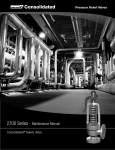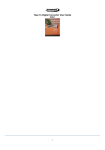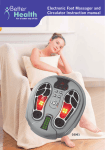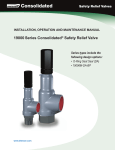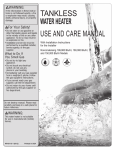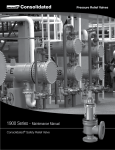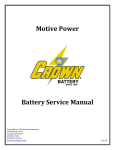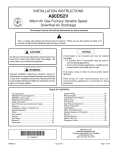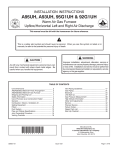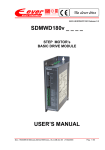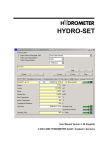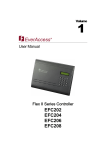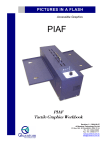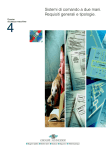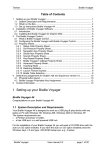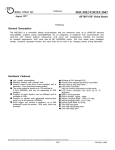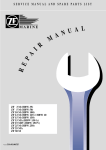Download 3500 EBV Series - Maintenance Manual
Transcript
Pressure Relief Valves 3500 EBV Series - Maintenance Manual Consolidated® Electromatic Ball Valve System Conversion Table All the USCS values in the Manual is converted to Metric values using following conversion factors: USCS Unit Conversion Factor Metric Unit1 in. 25.4 mm lb. 0.4535924 kg in2 6.4516 cm2 ft3/min 0.2831685 m3/min gal/min 3.785412 L/min lb/hr 0.4535924 kg/hr psig 0.6894757 barg ft lb 1.3558181 Nm °F 5/9 (°F-32) °C Note 1: Multiply USCS value with Conversion Factor to get Metric value. NOTICE! For valve configurations not listed in this manual, please contact your local GreentagTM Center for assistance. 2 | Dresser Consolidated® Table of Contents Section Subject Page No I. Product Safety Sign & Label System ������������������������������������������������������������������������������������ 5 II. Safety Alerts������������������������������������������������������������������������������������������������������������������������� 6 III. Safety Notice������������������������������������������������������������������������������������������������������������������������ 9 IV. Warranty Information����������������������������������������������������������������������������������������������������������� 10 V. Valve Terminology��������������������������������������������������������������������������������������������������������������� 11 VI. Handling and Storage��������������������������������������������������������������������������������������������������������� 13 VII. Design Features and Nomenclature������������������������������������������������������������������������������������ 14 VIII. Introduction������������������������������������������������������������������������������������������������������������������������ 14 IX. Consolidated 3500 Series Safety Valves����������������������������������������������������������������������������� 15 X. Operating Principles������������������������������������������������������������������������������������������������������������ 19 XI. Recommended Installation Practices�������������������������������������������������������������������������������� 20 A. Main Valve������������������������������������������������������������������������������������������������������������������� 20 B. Type 3539 Controller �������������������������������������������������������������������������������������������������� 20 C. Required Wire Gauge ������������������������������������������������������������������������������������������������� 21 XII. Disassembly of 3500 Series Safety Valve�������������������������������������������������������������������������� 22 A. Ball, Seat and Loader Assembly Removal�������������������������������������������������������������������� 22 B. Actuator Assembly removal����������������������������������������������������������������������������������������� 22 C. Stem Removal ������������������������������������������������������������������������������������������������������������ 23 D. Cleaning���������������������������������������������������������������������������������������������������������������������� 23 XIII. Maintenance Instructions�������������������������������������������������������������������������������������������������� 24 A. Seat Leakage�������������������������������������������������������������������������������������������������������������� 24 B. Packing Leakage �������������������������������������������������������������������������������������������������������� 24 C. Electrical System ������������������������������������������������������������������������������������������������������� 25 XIV. Inspection and Part Replacement��������������������������������������������������������������������������������������� 35 XV. Reassembly of 3500 Series Safety Valve�������������������������������������������������������������������������� 35 A. Lubrication ����������������������������������������������������������������������������������������������������������������� 35 B. Tools Required ������������������������������������������������������������������������������������������������������������ 35 C. Valve Assembly ����������������������������������������������������������������������������������������������������������� 35 D. E. Actuator and Accessory Assembly for Ledeen Models VA123 Actuators��������������������� 39 A ctuator and Accessory Assembly for Ledeen GS & SY Series Actuators������������������� 37 3500 EBV Series Safety Valve (March/2011) | 3 Table of Contents Section Subject Page No XVI. Setting and Testing������������������������������������������������������������������������������������������������������������ 41 A. Start-Up of the System������������������������������������������������������������������������������������������������ 41 A.1 Prior to Start Up Checks ������������������������������������������������������������������������������������� 41 A.2 System Start Up ������������������������������������������������������������������������������������������������� 41 A.3 Adjusting the Set Pressure and Blowdown ���������������������������������������������������������� 41 A.4 Minimum Blowdown Setting �������������������������������������������������������������������������������� 43 B. Hydrostatic Testing������������������������������������������������������������������������������������������������������ 43 XVII. Troubleshooting������������������������������������������������������������������������������������������������������������������ 44 XVIII. Maintenance Tools�������������������������������������������������������������������������������������������������������������� 45 XIX. Replacement Parts Planning��������������������������������������������������������������������������������������������� 47 A. General Information ���������������������������������������������������������������������������������������������������� 47 B.Inventory Planning - Replacement Parts List ��������������������������������������������������������������� 47 C.Identification and Ordering Essentials ������������������������������������������������������������������������� 48 XX. Genuine Dresser Parts�������������������������������������������������������������������������������������������������������� 48 XXI. Recommended Spare Parts������������������������������������������������������������������������������������������������ 48 XXII. Manufacturer's Field Service & Repair Program��������������������������������������������������������������� 49 A. Factory Setting vs. Field Setting ���������������������������������������������������������������������������������� 49 B. Field Service ��������������������������������������������������������������������������������������������������������������� 49 C. Factory Repair Facilities����������������������������������������������������������������������������������������������� 49 D. Safety Valve Maintenance Training������������������������������������������������������������������������������ 49 Sales Office Locations������������������������������������������������������������������������������������������������������������������� 50 4 | Dresser Consolidated® I. Product Safety Sign and Label System If and when required, appropriate safety labels have been included in the rectangular margin blocks throughout this manual. Safety labels are vertically oriented rectangles as shown in the representative examples (below), consisting of three panels encircled by a narrow border. The panels can contain four messages which communicate: • The level of hazard seriousness • The consequence of human, or product, interaction with the hazard. • The instructions, if necessary, on how to avoid the hazard. The top panel of the format contains a signal word (DANGER, WARNING, CAUTION or ATTENTION) which communicates the level of hazard seriousness. The center panel contains a pictorial which communicates the nature of the hazard, and the possible consequence of human or product interaction with the hazard. In some instances of human hazards the pictorial may, instead, depict what preventive measures to take, such as wearing protective equipment. The bottom panel may contain an instruction message on how to avoid the hazard. In the case of human hazard, this message may also contain a more precise definition of the hazard, and the consequences of human interaction with the hazard, than can be communicated solely by the pictorial. Do not remove bolts if pressure in line, as this will result in severe personal injury or death. 2 DANGER — Immediate hazards which WILL result in severe personal injury or death. 2 • The nature of the hazard 1 1 WARNING — Hazards or unsafe practices which COULD result in severe personal injury or death. 3 CAUTION — Hazards or unsafe practices which COULD result in minor personal injury. 4 ATTENTION — Hazards or unsafe practices which COULD result in product or property damage 3 Know all valve exhaust/ leakage points to avoid possible severe personal injury or death. 4 Wear necessary protective equipment to prevent possible injury Handle valve carefully. Do not drop or strike. 3500 EBV Series Safety Valve (March/2011) | 5 II. Safety Alerts! Read - Understand - Practice 1. Danger: High temperature/pressure can cause injury. Be sure all system pressure is absent before repairing or removing valves. 2. Danger: Don’t stand in front of valve outlet when discharging, Stand Clear of Valve to prevent exposure to trapped, corrosive media. Do not remove bolts if pressure in line, as this will result in severe personal injury or death Improper use or repair of pressurized device may result in severe personal injury or death 3. Danger: when inspecting a pressure relief valve for leakage, Be Very Careful! 1. W arning: Allow the system to cool to room temperature before cleaning, servicing or repairing the system. Hot components or fluids can cause severe personal injury or death. 2.Warning: Always read and comply with safety labels on all containers. Do not remove or deface the container labels. Improper handling or misuse could result on severe personal injury or death. 3.Warning: Never use pressurized fluids/gas/air to clean clothing or body parts. Never use body parts to check for leaks or flow rates or areas. Pressurized fluids/gas/air injected into or near the body can result in severe personal injury or death. Need all container label warnings XXX Do not work with valves while under the influence of intoxicants or narcotics 6 | Dresser Consolidated® Provide and use guarding to prevent contact with heated and/or pressurized parts. ? All potential hazards may not be covered in this manual 4.Warning: It is the responsibility of the owner to specify and provide guarding to protect persons from pressurized or heated parts. Contact with pressurized or heated parts can result in sever personal injury or death. 5.Warning: Do not allow anyone under the influence of intoxicants or narcotics are a hazard both to themselves and other employees and can cause severe personal injury or death to themselves or others. 6.Warning: Incorrect service and repair could result in product or property damage or severe personal injury or death. Refer XII.C. 7.Warning: These Warnings are as complete as possible but not all-inclusive. Dresser cannot know all conceivable service methods nor evaluate all potential hazards. 8.Warning: Use of improper tools or improper use of right tools could result in personal injury or product or property damage. II. Safety Alerts! (Contd.) Read - Understand - Practice 9. Warning: This valve product is not indented for radioactive nuclear applications. Some valve products manufactured by Dresser Consolidated® may be used in radioactive environments. Consequently, prior to starting any operation in a radioactive environment, the proper “health physics” procedures should be followed, if applicable. Improper tools or improper use of right tools could result in personal injury or product damage Know nuclear "health physics" procedures, if applicable, to avoid possible severe personal injury or death 1. Caution: Heed all service manual warnings. Read installation instructions before installing valve(s). 2. Caution: Wear hearing protection when testing or operating valves. 3. Caution: Wear appropriate eye and clothing protection. 4. Caution: Wear protective breathing apparatus to protect against toxic media. Note: Any service questions not covered in this manual should be referred to Dresser's Service Department. Phone: (318) 6406055 Know nuclear "health physics" procedures, if applicable, to avoid possible severe personal injury or death Need all Service Manual warnings, Read Installation instructions before installing valve(s). Wear necessary protective equipment to prevent possible injury Wear necessary protective equipment to prevent possible injury 3500 EBV Series Safety Valve (March/2011) | 7 II. Safety Alerts! (Contd.) Read - Understand - Practice Safety Precautions Follow all plant regulations, but be sure to observe the following: •Always eliminate the working pressure before making any valve adjustments or repairs. This will preclude severe personal injury or death •Do not stand in front of the discharge of a valve when testing or operating •Hearing protection should always be used when testing or operating a valve. •Wear protective clothing. Hot water can burn and super-heated steam is not visible. •When removing a power operated safety relief valve from a system, stand clear and/or wear protective clothing to prevent exposure to spatter, or any corrosive process medium, which may have been trapped inside the valve. Ensure the valve is isolated from system pressure before valve is removed. •Exercise care when examining a power operated safety relief valve for audible or visible leakage to avoid possible personal injury. Eliminate pressure and stand clear of discharge when working on valve to avoid severe personal injury or death •Prior to each actuation, ensure that no personnel are near the valve exhaust point. Media escaping from the valve during actuation can possibly cause personal injury. •Never tamper with the valve when system pressure is near the valve set pressure •Before performing any machining on valve parts, consult Dresser Consolidated® or its authorized representative. •All valves require periodic inspection and tests by qualified persons to insure that the valves are in proper working condition, and will function as designed by Dresser Consolidated®. •The Owner/operator of the valves must be aware of usage condition, and must bear the responsibility for determining the appropriate frequency of examination of the valves. •Do not attempt to repack a power actuated relief valve while it is pressurized. •Use care when making wiring connections on electrical components and when making valve setting adjustments to avoid electrical shock. Avoid Electric Shock 8 | Dresser Consolidated® Wear necessary protective equipment to prevent possible injury Know all valve exhaust/ leakage points to avoid possible severe personal injury or death. III. Safety Notice Proper installation and start-up is essential to the safe and reliable operation of all valve products. The relevant procedures recommended by Dresser Consolidated®, and described in these instructions, are effective methods of performing the required tasks. It is important to note that these instructions contain various “safety messages” which should be carefully read in order to minimize the risk of personal injury, or the possibility that improper procedures will be followed which may damage the involved Dresser Consolidated® product, or render it unsafe. It is also important to understand that these “safety messages” are not exhaustive. Dresser Consolidated® can not possibly know, evaluate, and advise any customer of all of the conceivable ways in which tasks might be performed, or of the possible hazardous consequences of each way. Consequently, Dresser Consolidated® has not undertaken any such broad evaluation and, thus, anyone who uses a procedure and/or tool, which is not recommended by Dresser Consolidated®, or deviates from Dresser Consolidated® recommendations, must be thoroughly satisfied that neither personal safety, nor valve safety, will be jeopardized by the method and/or tools selected. If not so satisfied, contact Dresser Consolidated® (at 318/640-6055) if there are any questions relative to tools/methods. Wear necessary protective equipment to prevent possible injury The installation and start-up of valves and/or valve products may involve proximity to fluids at extremely high pressure and/or temperature. Consequently, every precaution should be taken to prevent injury to personnel during the performance of any procedure. These precautions should consist of, but are not limited to, ear drum protection, eye protection, and the use of protective clothing, (i.e., gloves, etc.) when personnel are in, or around, a valve work area. Due to the various circumstances and conditions in which these operations may be performed on Dresser Consolidated® products, and the possible hazardous consequences of each way, Dresser Consolidated® can not possibly evaluate all conditions that might injure personnel or equipment. Nevertheless, Dresser Consolidated® does offer certain Safety Precautions, listed in Section II, for customer information only. It is the responsibility of the purchaser or user of Dresser Consolidated® valves/ equipment to adequately train all personnel who will be working with the involved valves/equipment. For more information on training schedules, call 318/640-6054. Further, prior to working with the involved valves/equipment, personnel who are to perform such work should become thoroughly familiar with the contents of these instructions. Additional copies of these instructions can be purchased, at a minimal cost, by contacting Dresser Consolidated® (in writing) at P.O. Box 1430, Alexandria, LA 71309-1430, or by calling at 318/ 640-2250, Fax (318) 640-6325. 3500 EBV Series Safety Valve (March/2011) | 9 IV. Warranty Information Warranty Statement - Dresser warrants that its products and work will meet all applicable specifications and other specific product and work requirements (including those of performance), if any, and will be free from defects in material and workmanship. Refer to Dresser’s Standard Terms of Sale, or specific contract for complete details on warranty and limitation of remedy and liability. Unauthorized Repair Work - Dresser Consolidated® has not authorized any non-Dresser affiliated repair companies, contractors or individuals to perform warranty repair service on new products or field repaired products of its manufacture. Therefore, customers contracting such repair services from unauthorized sources must do so at their own risk. Defective and nonconforming items must be held for Dresser’s inspection and returned to the original F.O.B. point upon request. Unauthorized Removal of Seals - All new valves and valves repaired in the field by Dresser Field Service are sealed to assure the customer of our guarantee against defective workmanship. Unauthorized removal and/or breakage of this seal will negate our warranty. Incorrect Selection or Misapplication of Products - Dresser Consolidated® cannot be responsible for customer’s incorrect selection or misapplication of our products. 10 | Dresser Consolidated® V. Valve Terminology (Paraphrased from ASME’s PTC 25) • Back Pressure • Lifting Device Back pressure is the static pressure existing at the outlet of a safety valve device due to pressure in the discharge system. • Blowdown Blowdown is the difference between actual popping pressure of a safety valve and actual reseating pressure expressed as a percentage of set pressure, or in pressure units. A lifting device is a device for manually opening a safety valve, by the application of external force to lessen the spring loading which holds the valve closed. • Back Pressure Back pressure is the static pressure existing at the outlet of a safety valve device due to pressure in the discharge system. • Bore Area • Blowdown Bore area is the minimum cross-sectional area of the seat bushing. • Bore Diameter Bore diameter is the minimum diameter of the seat bushing. • Built-Up Back Pressure Pressure existing at the outlet of a safety valve while it is open and flowing through a discharge system. • Chatter Chatter is abnormal, rapid reciprocating motion of the moveable parts of a safety valve, in which the disc contacts the seat. • Closing Pressure Closing pressure is the value of decreasing inlet static pressure at which the valve disc re-establishes contact with the seat, or at which lift becomes zero. • Disc A disc is the pressure containing moveable member of a safety valve which effects closure. • Bore Area Inlet size is the nominal pipe size of the inlet of a safety valve, unless otherwise designated. Leak test pressure is the specified inlet static pressure at which a quantitative seat leakage test is performed in accordance with a standard procedure. Bore diameter is the minimum diameter of the seat bushing. • Built-Up Back Pressure Pressure existing at the outlet of a safety valve while it is open and flowing through a discharge system. • Chatter Chatter is abnormal, rapid reciprocating motion of the moveable parts of a safety valve, in which the disc contacts the seat. • Closing Pressure Closing pressure is the value of decreasing inlet static pressure at which the valve disc re-establishes contact with the seat, or at which lift becomes zero. • Disc • Leak Test Pressure Bore area is the minimum cross-sectional area of the seat bushing. • Bore Diameter • Inlet Size Blowdown is the difference between actual popping pressure of a safety valve and actual reseating pressure expressed as a percentage of set pressure, or in pressure units. A disc is the pressure containing moveable member of a safety valve which effects closure. • Inlet Size Inlet size is the nominal pipe size of the inlet of a safety valve, unless otherwise designated. • Lift • Leak Test Pressure Lift is the actual travel of the disc away from closed position when a valve is relieving. Leak test pressure is the specified inlet static pressure at which a quantitative seat leakage test is performed in accordance with a standard procedure. 3500 EBV Series Safety Valve (March/2011) | 11 V. Valve Terminology (Contd.) • Lift • Rated Lift Lift is the actual travel of the disc away from closed position when a valve is relieving. Rated lift is the design lift at which a valve attains its rated relieving capacity. • Lifting Device • Safety Valve A lifting device is a device for manually opening a safety valve, by the application of external force to lessen the spring loading which holds the valve closed. • Seat Bushing • Set Pressure A seat bushing is the pressure containing element which constitutes the inlet flow passage and includes the fixed portion of the seat closure. • Outlet Size Outlet size is the nominal pipe size of the outlet passage of a safety valve, unless otherwise designated. Overpressure is a pressure increase over the set pressure of a safety valve, usually expressed as a percentage of set pressure. Popping pressure is the value of increasing inlet static pressure at which the disc moves in the opening direction at a faster rate as compared with corresponding movement at higher or lower pressures. It applies only to safety or safety relief valves on compressible fluid service. • Pressure Containing Member 12 | Dresser Consolidated® Seat tightness pressure is the specific inlet static pressure at which a quantitative seat leakage test is performed in accordance with a standard procedure. • Simmer A pressure containing member of a safety valve is a part which is in actual contact with the pressure media in the protected vessel. A pressure retaining member of a safety valve is a part which is stressed due to its function in holding one or more pressure containing members in position. Seat diameter is the smallest diameter of contact between the fixed and moving members of the pressure containing elements of a valve. • Seat Tightness Pressure • Pressure Retaining Member A seat is the pressure containing contact between the fixed and moving portions of the pressure containing elements of a valve. • Seat Diameter • Popping Pressure Set pressure is the value of increasing inlet static pressure at which a safety valve displays the operational characteristics as defined under “Popping Pressure.” It is one value of pressure stamped on the safety valve. • Seat • Overpressure A safety valve is a pressure relief valve actuated by inlet static pressure and characterized by rapid opening or pop action. Simmer is the audible or visible escape of fluid between the seat and disc at an inlet static pressure below the popping pressure and at no measurable capacity. It applies to safety valves on compressible fluid service. • Warn See “Simmer” (definition above). VI. Handling and Storage The valve either crated or un-crated, should always be kept with the inlet down. (i.e., never laid on its side). Never attempt to lift the full weight of the valve by the actuator tubing, solenoid valve, junction box, etc. Electromatic® Ball valves should be stored, in their original shipping crates, in a dry environment, to protect them from the weather. They should not be removed from the crates until immediately prior to installation. The inlet and outlet protectors should not be removed until the valves are ready for installation into the system. Do not position inlet flange horizontally, or lift value by tubing assembly or external devices Electromatic® Ball valves, either crated or un-crated, should never be subjected to sharp impact. This would most likely to occur by bumping or dropping during loading or unloading from a truck, or while moving with a power conveyor, such as a fork lift truck, or while hoisting during installation, care should be exercised to prevent bumping the valve against structures or other objects. When Electromatic® Ball valves are un-crated, and the inlet and outlet protectors are removed immediately prior to the installation, meticulous care should be exercised to prevent dirt, or other foreign materials, from entering the inlet and outlet ports while installing the valves. Improper tools or improper use of right tools could result in personal injury or product damage Do not allow dirt or foreign matter to enter the inlet or outlet points 3500 EBV Series Safety Valve (March/2011) | 13 VII.Design Features and Nomenclature Figure 1 illustrates the relationship of the various elements of the Power Actuated Relief Valve System. The Type 3539 Controller consists of a pressure sensing element (i.e., a bourdon tube), an electrical relay and control box which houses the electrical relay and sensing element. The Type 2537 Control Station is a 3 position selector which allows selection of Manual actuation, Off or Automatic actuation. It consist of a box, selector switch and two indicator lights (red and amber). The Pneumatic Actuator Assembly consists of a double acting pneumatic actuator, two three way solenoid valves (one normally open and one normally closed), and one actuator mounted Westlock switch which contains two SPDT limit switches. The electrical supply system consists of a control circuit and a solenoid circuit. The field wiring must have insulation suitable for at least 600 volts. The solenoid insulation is Class F. Environmental Conditions: • Indoor or outdoor use • Elevation (maximum) 2000 M • Operating ambient temperature maximum 140°F (60°C). (CE certified at 40°C maximum) • Pollution Degree - 2 • Over voltage category III • Main supply voltage fluctuations voltage • 2537 Control Station - Nema (IP) • 3539 Controller - Nema 4 (IP) • Top mount Controller Assy - Nema (IP) Discharge Stack 3539 Controller Shut Off Valve 3500 Series Electromatic Ball Valve CLOSED From Steam Header Solenoid Voltage Supply of the nominal • Protection Classification The solenoid circuit provides the voltage needed for the solenoid. The solenoid power supply wiring must be sized so that the voltage drop, due to the solenoid inrush current, does not exceed 5%. Siphon +10% -5% Electrical Supply Drain & Test Valve 2537 Control Station Pneumatic Level Isolating Gate Valve Header Control Voltage Supply Figure 1: Consolidated Electronic Ball Valve Systems VIII.Introduction The Consolidated® Electromatic Ball Valve is an electrically controlled pneumatically actuated pressure relief device. It may be manually operated by closing a switch, or automatically operated at specified opening and closing pressure. The application provides the plant operator with a means of instantaneously opening and closing a relief valve at a remote location. 14 | Dresser Consolidated® When the pressure element is set to open the Electronic Ball Valve at a pressure slightly below the lowest set spring loaded safety valves, it will prevent the safety valves from opening except during major overpressure excursions. IX. Consolidated 3500 Series Safety Valves Part No. 7 11 12 10 2 19 22 6 8 15 16 9 5 3 4D 4E 1 4A 4B 4C 13 14 24 Figure 2: 3500 Valve Typical Flange Inlet. 1 Body 2 Yoke 3 Discharge Collar 4 Ball & Seat Assembly 4A Seat 4B Ball 4C Loader 4D Belleville Washer 4E Split Spacer Ring 5 Gasket 6 Stem 7 Stem Nut 8 Bearing Washer 9 Packing Gland Flange 10 Packing Gland 19 2 11 Packing Ring 22 16 12 Packing Stop Washer 9 13 Discharge Collar Studs 10 14 Discharge Collar Nuts 15 15 Stud Packing Gland 7 16 Nut Packing Gland 17 Cap Screw Yoke/Body 18 Lock Washer Yoke/ Body 19 Drive Bushing 20 Cap Screw Yoke/ Actuator 21 Lock Washer Yoke/ Actuator 22 Key Stem 23 Set Screw 24 Drain 25 Actuator Assembly 3 17 18 12 11 8 13 Nomenclature 14 5 4A 4B 4C 4E Figure 3: 3500 Valve Typical Buttweld Inlet. 4D 1 25A Actuator 3500 EBV Series Safety Valve (March/2011) | 15 IX. Consolidated 3500 Series Safety Valves (Contd.) 25K 25L 25L Part No. 25A 25K Nomenclature 25B Solenoid (Open) 25C Solenoid (Closed) 25D Position Switch 25E Bracket 25F Cap Screw Bracket/ Actuator 25G Lock Washer Bracket/ Actuator 25H Cap Screw Bracket/ Switch 25J Lock Washer Bracket/ Switch CLOSED BEACON CLOSED 25B 25Q 25C 25K Close Nipple Pipe 1/2”-14F NPT 25P 25U 25M 25N 25S 25S 25S 25L Flush Bushing 25M Conduit Fitting Straight 25N Pipe Plug 25P Tee Pipe 23 19 25Q Nipple Pipe 6" Length 20 25R Elbow Pipe 21 25S Tubing 17 18 25T Tube Fitting Union Elbow 25U Tube Fitting Union 25V Male Branch Tee 25W Male Run Tee 25R CLOSED 25T 25E 25H 25J 25D 25F 25G 25T 25T Figure 4: Valve Actuator Assembly (GS620/GS628 Actuator) NOTE: The Drive Bushing that connects the Ledeen GS620 and 628 Actuators with the Stem of the Ball Valve may float up inside the Actuator during re-assembly. A temporary application (during disassembly), of duct-tape or a 4" hose clamp will hold it in position with about ¾ of an inch of bushing showing below the actuator. Following re-assembly remove any duct-tape or hose clamp from the drive bushing and insure that the drive bushing set screw is tight. 16 | Dresser Consolidated® 26 Pressure Regulator 27 Filter 28 Nipple Pipe 3" Length 29 Check Valve 30 Cross Pipe 31 Hex Nipple Pipe 32 Thread Protector 33 Rupture Disc IX. Consolidated 3500 Series Safety Valves (Contd.) 25A CLOSED BEACON CLOSED 25U 25B 25C 1/2”-14F NPT 25Q 25P 25U 25M 25N 25S 25S 23 18 17 20 21 22 25R CLOSED 25G 25F 25T 25K 25L 25E 25H 25J 25D 25L 25K 25T 25T Figure 5: Valve Actuator Assembly (SY1032/SY1043 Actuator) 3500 EBV Series Safety Valve (March/2011) | 17 IX. Consolidated 3500 Series Safety Valves (Contd.) 25S 25U 25T 25L 25K 25V 25S 25W 26 1/2” - 14F NPT 28 CLOSED BEACON 27 CLOSED Figure 7: Pressure Regulator & Filter 25S 25S 25B 25R 25Q 25C 1/2”-14F NPT 25P 25U 25M 25N 25S 32 29 33 31 TO ACTUATOR FLOW FLOW 30 17 32 23 18 19 20 Figure 8: Auxiliary Supply Manifold 21 CLOSED 25H 25U 25E 25J 25F 25D 25G 25T Figure 6: Valve Actuator Assembly (VA123 Actuator) 18 | Dresser Consolidated® 29 X. Operating Principles Electrical System of each switch. When the pressure increases to the "set point", High Pressure Switch C is actuated and completes the relay circuit that energizes the valve solenoid. The Low Pressure Switch D then provides for relay control below the actuation value of the High Pressure Switch, thereby allowing an adjustable blow down for the Electromatic® Valve. This action makes extremely sensitive regulation possible. The Electromatic® Ball Valve is a 90 degree turn "open to close", electrically controlled, pneumatically actuated relief valve. Automatic actuation at a predetermined set pressure is accomplished by a 3539 controller. The Field Wiring must have insulation suitable for at least 600 volts. The Type 2537 Control Station, which includes a switch and two lights, Is a small unit that can be mounted in a control panel. The Type 3539 Controller is actuated by the pressure in any vessel to which it is connected. The construction of the Controller is such that it will make and break electrical contact with a difference in pressure of 1-1/2% of the "set pressure". Within the Controller (see Figure 9) is the Dual Control Pressure Switch. The Control Station is electrically connected to the Type 3539 Controller. With the Control Station Switch in the "automatic" position (see Figure 10), the "amber" light turns on and remains on until the valve is opened. Adjusting Screws A and B determine the operating point ELECTROMATIC RELIEF VALVE TYPE 2537 CONTROL STATION E WHIT ITE WH PURPLE MOV RED RED RED W RED HI BR D TE OW OW N O RED AMBER RE OFF RED OR BLACK RA RED D UE E G N BL VALVE CLOSED MAN. LL YE ATTACH TO GROUND LUG ON DOOR VALVE OPEN AUTO ALEXANDRIA, LOUISIANA 71301 C B E A Figure 9: 3539 Controller When the pressure reaches the predetermined point, at which the valve is set to open, contact is made in the Type 3539 Controller, resulting in the relay closing. Accordingly, the solenoid valves are energized, and the valve opens. At this time the "red" light in the Type 2537 Control Station turns on which indicates that the valve is open. When the pressure decreases below the adjusted closing point of the valve, the relay de-energizes and this, in turn, de-energizes the solenoid valves, and causes the valve to close. The "red" light in the Type 2537 Control Station will then go off, and the "amber" light will go Figure 10: Control Station 2537 on. The lights on the control station are controlled by a position switch on the actuator. When it is desirable to open the valve "manually", this can be accomplished by simply pushing the Control Station Switch to the "manual" position. To close the valve, it is only necessary to push the Control Station Switch to the "off" position. Note:Remember that when the switch Is In the "automatic" position, the valve will open at the predetermined pressure for which it is set. 3500 EBV Series Safety Valve (March/2011) | 19 XI. Recommended Installation Practices A. Main Valve The power actuated Relief Valve is customarily installed either on a superheater, or on a manifold fed by two or more boilers. To facilitate servicing, an Isolation Valve should be installed directly below the Main Valve, as shown in Figure 11. (Refer to ASME Code Restrictions for code stamped valves). Care should taken to ensure that mechanical strains from the discharge piping are not transmitted to the Electronic Ball Value. Such Strains are detrimental to good valve performance. The discharge pipes should have adequate steam capacity and should be of a size to provide for movement caused by thermal expansion. Discharge piping should be drained to prevent the accumulation of water in the valve outlet. At no time should the discharge piping bear against the drip pan, or the nipple therein. The riser piping should be securely anchored to the building structure, and never to the valve, in order for it to resist the reactive forces of the discharged steam. The Drains should be piped in such a manner as to prevent the unnecessary escape of steam into any enclosure, and to keep foreign material from being blown back into the valve from other sources (Refer to Figure 11). Support Drain Discharge Stack 3500 Ball Valve Wear necessary protective equipment to prevent possible injury Cover the main valve outlet, during system shut downs, when the valve is not in service, or is not pressurized, to prevent foreign matter from entering into the main valve. B. Type 3539 Controller Care must be taken in mounting the Controller, since it will not operate properly if subjected to vibration. It is recommended that the Controller be mounted directly to the building structure and, depending on the installation, it may even be advisable to mount the Controller on some type of shock absorbing material, in order to isolate it from the any vibration in the building structure. Since the sensing line from the pressure vessel may also transmit vibrations to the controller, precautions should be Support Before disassembling the valve, ensure there is no media pressure in the vessel. Discharge Stack CLOSED Drain 3500 Ball Valve Figure 11: Recommended Exhaust Stack Installation 20 | Dresser Consolidated® Valve caps and bonnets can trap fluids. Use caution when removing to prevent injury or environmental damage. XI. Recommended Installation Practices (Contd.) taken to eliminate this possibility. Dresser Consolidated® suggests that several loops of high-pressure tubing be used to accomplish this task. Further, the pressure sensing connection should be mounted at least eight to ten pipe diameters upstream from the Electronic Ball Valve in order to provide a stable pressure signal. Finally, if the Controller may be subjected to freezing temperatures, a heating element should be added to prevent freezing of the bourdon tube. C. Required Wire Gauge The electrical supply to the controller (solenoid voltage) should have stranded wiring. The wire should be no smaller than 12 AWG. If necessary, the wire should be larger than 12 AWG, to prevent more than a 5% voltage drop to the solenoid inrush current. Table 1: Optional Voltage Type 3500 Ball Valve Voltage Frequency Amperage 100 - 240 AC 50 - 60 HZ .3 24,48,100 - 240 DC N/A 1.0 Welding Caution This valve contains a ball & seat assembly that has been coated for wear resistance and may be damaged if exposed to elevated temperatures associated with welding and post weld heat treatment. Welding interpass temperatures should be in compliance with ASME B&PV Code Section IX but should not exceed 570°F (299°C). Local post weld heat treatment of the weld and heat affected zone is recommended. If this entire valve body is to receive post weld heat treatment, the hall and seat assembly should be removed. The bushing gasket must not be reused after disassembly. Refer to Valve service manual of disassembly and assembly instructions. 3500 EBV Series Safety Valve (March/2011) | 21 XII. Disassembly of 3500 Series Safety Valve Caution: Make sure that no pressure is in the valve prior to disassembly. If equipped with an isolation valve, close the isolation valve and actuate the EBV valve open closed to remove all pressure. If not equipped with an isolation valve, the unit must be shut down prior to disassembly. A.Ball, Seat and Loader Assembly Removal Refer to Figure 2 and 3 1.If the ball, seat and loader assembly is to be removed while on the unit and the installation is equipped with an isolation valve, close the isolation valve. Actuate the EBV from open to close to relieve any pressure between the EBV and the isolation valve, if not equipped with an isolation valve, the unit must be shut down prior to disassembly. 2.If disassembling on the unit, remove the discharge stack. If the valve is not in the closed position. Caution: Do not actuate the valve with the collar removed. Damage to the ball may result. Figure 12: Ball Placement and Removal Tool (Make Locally) 3. Loosen and remove the body stud nuts. 4. Lift the discharge collar off the valve. 5.Two threaded holes are provided so that a bolt or all-thread can be used to remove the seat. The 1.5” (38.1 mm) and 2” (50.8 mm) size valves are tapped with a #10-32 thread. The 2.5” (63.5) size valves are tapped with a 0.25” (6.35 mm)-20 thread. Screw two bolts or two pieces of all-thread into the threaded holes. Lift the seat out of the body. 6.Using two lifting hooks illustrated in Figure 12, remove the ball. This is accomplished by inserting the hooked end into the flow port of the ball and lifting upward. 7.Insert the hock end of one of the lifting hooks under the sear loader and rotate the loader until it’s bore is perpendicular to the body bore. Lift the loader up and out of the body. 8. Remove the Belleville washer and the split ring spacer. B.Actuator Assembly Removal Refer to Figures 4,5 or 6 1.Shut off the service air line and disconnect it from the actuator. 2.Shut off the electrical supply to the actuator mounted westlock switch. Disconnect electrical wires and conduit coming from the controller to the westlock switch. 3.Attach a strap sling around the cylinder portion of the actuator at the end near the housing. NOTE: Do not connect a lifting device to the westlock switch, solenoid valves or tubing. Hook a chain hoist or other suitable lifting device to the strap sling. Adjust the hoist until no slack is in the line. Loosen and remove the four actuator mounting bolts connecting the yoke to the valve body. Slide the actuator and yoke assembly away from the valve until the mounting yoke is clear of the drive bushing. 22 | Dresser Consolidated® XII. Disassembly of 3500 Series Safety Valve (Contd.) C.Stem Removal Refer to Figures 2 and 3 Retainer Plate 1.Apply a temporary piece of duct-tape or a 4” (101.6 mm) hose clamp to the Drive Bushing to prevent it from floating up into the actuator. Approximately .75” (19 mm) of the drive bushing should show below the actuator. Part No Used On 4949001 3515, 3516, 3525, 3526 4947001 3517, 3527, 3537 4946901 3538, 3547 2.Loosen the allen head set screw in the drive bushing. Slide the bushing off the stem and remove the drive key. 3.Loosen and remove the two packing gland stud nuts. Remove the packing gland flange and the packing gland. 4.Using a wire hook or screw driver, dig out the 316 Stainless Steel with Flexible Graphite Fillers (Spiral Wound) packing. The packing stop washer is drilled and tapped with two #10-32 threaded holes. Screw a piece of all-thread or a #10-32 screw approximately 3" (76.2 mm) long into one of the holes in the packing stop ring. Slide the packing stop ring off the stem. The stem nut can now be removed using the stem nut wrench, illustrated in Figure 13a & 13b. Rotate the nut counterclockwise to remove it. 5.Remove the stem and bearing washer from the body. Stem Nut Removal Tool Part No Used On 4948901 3515, 3516, 3525,3526 4947101 3517, 3527, 3537 4945701 3538, 3547 Figure 13b: Retainer Plate D.Cleaning The 3500 Electronic Ball Valve parts may normally be cleaned with wire brushes, and low pressure air. Whatever method is used, clean the parts safely and use care to prevent damage to the environment. If internal parts are cleaned with industrial solvents or cleaning solutions, take precautions to protect yourself from potential danger of breathing fumes, chemical burns, or explosion. See the Manufactures Safety Data Sheet for safe handling instructions and information about protective clothing and equipment for use when working with the chemical. The outside surfaces of the Actuator, 2537 Control Station, and 3539 Controller Box may be cleaned by wiping with a damp cloth. Figure 13a: Stem Nut Removal Tool Follow recommendations for safe handling in the solvent's. Material Safety Data Sheet and observe safe practices for any cleaning method. 3500 EBV Series Safety Valve (March/2011) | 23 XIII. Maintenance Instructions A. Seat leakage If leakage should occur use the following procedure to determine and correct the cause: 1.Verify that the normally closed solenoid valve is energized and vented. To accomplish this, check the voltage across terminal 2 and 3 in the actuator junction box. There should be voltage at these terminals when the valve is closed. If no voltage is present, check continuity across terminals 3 and 4. There should be continuity across these terminals when the valve is closed. If there is no continuity, adjust the closed side actuator switch lever cam until the circuit is closed. Actuate the valve and check for leakage. 2.If the switch is properly adjusted and leakage continues, the ball and seat assembly must be removed and checked. The valve must be isolated from system pressure before it can be disassembled. Using the procedures outlined in the disassembly section of this manual remove the Adapter Flange and Ball and Seat assembly. Inspect the spherical radius in the seat for cutting or flaking of the chrome carbide. Inspect the spherical radius of the ball for cutting or flaking of the chrome carbide. Very light flaking at the edge of the bore is acceptable. If the seat is damaged and the ball has galling or flaking of the carbide coating the entire ball and seat and loader assembly must be replaced. Remove the old gasket and clean the gasket surfaces of the body and the busing. Reassemble the valve using the procedures outlined in the assembly section of this manual. Pressurize and actuate the valve. Check for leakage. 3.If a new ball, seat and loader assembly has been installed and the valve still leaks, the stem bearing 24 | Dresser Consolidated® pad must be replaced. Refer to the disassembly and assembly section of this manual for disassembly and assembly instruction. The valve must be isolated from system pressure when removing and replacing the stem bearing pad. New packing must be installed each time the stem is removed. B. Packing Leakage Should packing leakage occur, tighten the two packing nuts in the quarter turn increments. Check after each quarter turn adjustment to see if leakage has stopped. The packing should be tightened only enough to stop the leakage. If the leakage can not be stopped by tightening the gland nuts, the valve should be repacked with new packing. The valve can be repacked without removing the actuator and actuator yoke if split ring service ring packing is used. Refer to Table 2 for part numbers. The EBV can also be repacked with 316 Stainless Steel1 rubber pack. If the electronic Ball valve is equipped with an isolator valve it must be closed to isolate the EBV. Open the EBV from open to closed to relieve pressure with an isolation valve, the unit must be shut down. Loosen the packaging gland bolts one full turn. Wait approximately two minutes to verify that the gland and flange does not move and reload the packing gland nuts. Loosen the actuator drive bushing lock screw and move the bushing away form the packing gland flange enough to slow removal of the packing gland slud nuts. Move XIII. Maintenance Instructions (Contd.) the packing gland flange and packing gland away from the stuffing box until the flange contacts the yoke. Using a wire hook similar to the one illustrated in Figure 12, or a packing remover, remove the 316 Stainless Steel1 packing from the stuffing box. Place the split ring packing around the stem below the packing gland. Use the gland to position the packing in the stuffing box. The correct number of rings is specified in Table 2. Install the packing gland nuts and tighten. Final adjustment must be made after the valve is pressurized. Tighten just enough to prevent leakage. Note 1: with Flexible Graphite Fillers (Spiral Wound) Table 2: Split Ring Service Packing Valve Type Part Number Quantity 3515, 3516, 3525, & 3526 4960902 3 3517, 3527 & 3537 4960901 3 3538 & 3547 4960903 3 C. Electrical System To inspect for proper wiring of the Controller, Control Station and the actuator, refer to Figure 14 and 15. If trouble is encountered in the Controller, the Control Station or the actuator, refer to the Trouble Shooting Chart shown in Table 5. Each block in the chart identifies a particular piece of equipment (Le., the Controller, the Control Station, the actuator assembly, etc.), and the terminal to check when the system is malfunctioning. Therefore, when numbers and letters, such as T7 or T8, are encountered in the Trouble Shooting Chart, these refer to specific terminals, such as 7 or 8, in a particular piece of equipment. Note:Supply wiring should be large enough to prevent more than a 5% voltage drop to the solenoid in-rush current. A voltage drop may cause the solenoid to fail. WIRE AWG 16 12 DIA (mm) 1.52 2.66 Note:A 5 AMP circuit breaker should be Installed to protect the controller. 3500 EBV Series Safety Valve (March/2011) | 25 XIII. Maintenance Instructions (Contd.) Solenoid Voltage Supplied By Customer CONTROL VOLTAGE SOLENOID VOLTAGE 3539 CONTROLLER INRUSH CURRENT HOLDING CURRENT CR2 NC CR1 MAN. OFF MAN. MAN. OFF OFF AUTO. AUTO. AUTO. SWITCH IN "AUTO POSITION "SWITCH IN "OFF" POSITION SWITCH IN "MAN" POSITION 16 AWG(2,34mm) RED EXHAUST CYLINDER "E" Pressure "P" C NO NC Relay Aux. Switch. CR4 16 AWG(2,34mm) RED Indicating Lamp CYLINDER EXHAUST EXHAUST "A" "E" Pressure "P" SOLENOID ENERGIZED CYLINDER "A" "E" Pressure "P" EXHAUST SOLENOID CYLINDER "A" "E" Pressure "P" Figure 14: Schematic Wiring Diagram Electromatic Valve 120VAC, 240VAC, 24VDC, & 125VDC 26 | Dresser Consolidated® PL DE-ENERGIZED SOLENOID "A" RED OR BLACK Normally Open 8316G66 ENERGIZED SOLENOID 16 AWG(2,34mm) Valve Shown in Closed Position Normally Closed 8316G64 DE-ENERGIZED 16 AWG (2,34mm) RED MAN. CR3 Relay Coil 16 AWG(2,34mm) YELLOW 2537 CONTROL STATION SWITCH LAYOUT 12 AWG(3,15mm) RED Relay Contacts OF F AUTO 12 AWG(3,15mm) RED PSH C NC NO 12 AWG(3,15mm) WHITE PSL C NO 12 AWG(3,15mm) WHITE Move To Be Same As Control Voltage 16 AWG(2,34mm) WHITE Indicating Lamp (Closed) T4 T3 T2 T1 16 AWG(2,34mm) RED 16 AWG (2,34mm) WHITE Pressure Switch WHITE 16 AWG (2,34mm) Indicating Lamp (Open) 16 AWG (2,34mm) RED 16 AWG(2,34mm) WHITE 16 AWG(2,34mm) RED 16 AWG(2,34mm) RED 16 AWG(2,34mm) WHITE 16 AWG(2,34mm) RED T8 T7 T6 T5 T4 T3 T2 T1 T10 T9 T8 T7 T6 T5 16 AWG(2,34mm) BROWN TERMINAL BLOCK 16 AWG (2,34mm) PURPLE Terminal Block 2537 Control Station Terminal Block Control Voltage Supplied by Customer XIII. Maintenance Instructions (Contd.) NOTE: CONTROLLER ASSY. T14 1. Broken lines(----) indicate field wiring by customer. T13 16 AWG(2,34mm) RED T12 16 AWG(2,34mm) GREEN T11 T9 16 AWG(2,34mm) RED 16 AWG(2,34mm) YELLOW T8 16 AWG(2,34mm) GREEN T7 16 AWG(2,34mm) YELLOW T10 T6 Normally Normally Closed Open Closed Open Solenoid Valve Solenoid Valve ASCO 8316P066 ASCO 8316P064 OPTIONAL Feed Back Signal to Customer's DCS DCS Supplied by Customer 16 AWG(2,34mm)WHITE/ BROWN 16 AWG(2,34mm)WHITE/ YELLOW 16 AWG(2,34mm)WHITE/ ORANGE 16 AWG(2,34mm) YELLOW 16 AWG(2,34mm) ORANGE 16AWG(2,34mm) BROWN 16 AWG(2,34mm) RED/WHITE 16 AWG(2,34mm) BLUE/WHITE T5 T4 T3 T2 NC 16 AWG(2,34mm) T1 TERMINAL BLOCK CR5 C BLACK/WHITE NO Limit NC Switch 16 AWG(2,34mm) BLUE 16 AWG(2,34mm) BLACK CR6 C NO 16 AWG(2,34mm) RED NC C NO LIMIT DPDT NC SWITCH C NO Contact Open Contact Closed Opening Cycle Contact Relay Valve Closed Mid Open Closing Cycle Valve Open Valve Open Mid Closed Valve Closed CR1 CR2 CR3 CR4 CR5 NC CONTACT CR6 NO CONTACT Figure 14 (Contd.): Schematic Wiring Diagram Electromatic Valve 120VAC, 240VAC, 24VDC, & 125VDC 3500 EBV Series Safety Valve (March/2011) | 27 XIII. Maintenance Instructions (Contd.) Solenoid Voltage Supplied By Customer CONTROL VOLTAGE SOLENOID VOLTAGE 3539 CONTROLLER INRUSH CURRENT HOLDING CURRENT CR2 NC CR1 MAN. MAN. MAN. OFF OFF OFF AUTO. AUTO. AUTO. SWITCH IN "AUTO POSITION "SWITCH IN "OFF" POSITION SWITCH IN "MAN" POSITION 16 AWG(2,34mm) RED CYLINDER EXHAUST SOLENOID "E" Pressure "P" C NO NC CR4 16 AWG(2,34mm) RED PL Indicating Lamp CYLINDER EXHAUST "A" "E" "E" Pressure "P" SOLENOID ENERGIZED CYLINDER EXHAUST "A" "E" Pressure "P" Figure 15: Schematic Wiring Diagram Electromatic Valve 220 VDC & 250 VDC 28 | Dresser Consolidated® Relay Aux. Switch. DE-ENERGIZED SOLENOID "A" RED OR BLACK Normally Open 8316G66 ENERGIZED EXHAUST 16 AWG(2,34mm) Valve Shown in Closed Position Normally Closed 8316G64 DE-ENERGIZED 16 AWG (2,34mm) RED MAN. CR3 Relay Coil 16 AWG(2,34mm) YELLOW 2537 CONTROL STATION SWITCH LAYOUT 12 AWG(3,15mm) RED Relay Contacts OF F AUTO 12 AWG(3,15mm) RED 12 AWG(3,15mm) WHITE PSH C NC NO 12 AWG(3,15mm) WHITE 16 AWG(2,34mm) BROWN PSL C NO Move To Be Same As Control Voltage 16 AWG(2,34mm) WHITE Indicating Lamp (Closed) T4 T3 T2 T1 RESISTOR 16 AWG (2,34mm) PURPLE 16 AWG (2,34mm) WHITE Pressure Switch WHITE 16 AWG (2,34mm) Indicating Lamp (Open) 16 AWG (2,34mm) RED 16 AWG(2,34mm) WHITE 16 AWG(2,34mm) RED 16 AWG(2,34mm) RED 16 AWG(2,34mm) WHITE 16 AWG(2,34mm) RED T8 T7 T6 T5 T4 T3 T2 T1 T10 T9 T8 T7 T6 T5 16 AWG(2,34mm) RED TERMINAL BLOCK RESISTOR Terminal Block 2537 Control Station Terminal Block Control Voltage Supplied By Customer SOLENOID CYLINDER "A" Pressure "P" XIII. Maintenance Instructions (Contd.) NOTE: CONTROLLER ASSY. T14 1. Broken lines(----) indicate field wiring by customer. T13 16 AWG(2,34mm) RED T12 16 AWG(2,34mm) GREEN T11 T9 16 AWG(2,34mm) RED 16 AWG(2,34mm) YELLOW T8 16 AWG(2,34mm) GREEN T10 Normally Normally Closed Open Closed Open Solenoid Valve Solenoid Valve ASCO 8316P066 ASCO 8316P064 OPTIONAL Feed Back Signal To Customer's DCS DCS Supplied By Customer 16 AWG(2,34mm) YELLOW T7 T6 16 AWG(2,34mm)WHITE/ BROWN 16 AWG(2,34mm)WHITE/ YELLOW 16 AWG(2,34mm)WHITE/ ORANGE 16 AWG(2,34mm) YELLOW 16 AWG(2,34mm) ORANGE 16AWG(2,34mm) BROWN 16 AWG(2,34mm) RED/WHITE 16 AWG(2,34mm) BLUE/WHITE T5 T4 T3 T2 NC 16 AWG(2,34mm) BLACK/WHITE T1 TERMINAL BLOCK CR5 C NO Limit NC Switch 16 AWG(2,34mm) BLUE 16 AWG(2,34mm) BLACK CR6 C NO 16 AWG(2,34mm) RED NC C NO LIMIT DPDT NC SWITCH C NO Contact Open Contact Closed Opening Cycle Contact Relay Valve Closed Mid Open Closing Cycle Valve Open Valve Open Mid Closed Valve Closed CR1 CR2 CR3 CR4 CR5 NC CONTACT CR6 NO CONTACT Figure 15 (Contd.): Schematic Wiring Diagram Electromatic Valve 220 VDC & 250 VDC 3500 EBV Series Safety Valve (March/2011) | 29 XIII. Maintenance Instructions (Contd.) OPTIONAL DCS CONTROL INTERFACE Required Terminals For Dry Contact Control Open/Closed Dry Solenoid Voltage Contact Control Supplied From DCS By Customer To Controller Assy. CR2 CR1 Terminal Block Relay Contacts CR3 16 AWG(2,34mm) RELAY COIL 16 AW G (2,34mm) RED 16 AWG(2,34mm) YELLOW 16 AWG(2,34mm) RED 12 AWG(3,15mm) RED 12 AWG(3,15mm) RED 12 AWG(3,15mm) WHITE NC PSH C NO NC 12 AWG(3,15mm) WHITE 16 AWG(2,34mm) BROWN PURPLE PSL 16 AWG(2,34mm) RED C NO MOV to Be Same As Control Voltage 16 AWG(2,34mm) WHITE Pressure Switch T4 T3 T2 T1 T10 T9 T8 T7 T6 T5 16 AWG(2,34mm) Terminal Block To 2537 Control Station RED or BLACK RELAY AUX. NC SWITCH C NO CR4 16 AWG(2,34mm) RED PL Indicating Lamp Valve Shown in Closed Position Required Terminals for Optional Heater/Thermostat Figure 16: Optional DCS Control Interface 120 VAC, 240 VAC, 125 VDC & 24VDC 30 | Dresser Consolidated® RED RED WHITE RED WHITE BROWN MOV to Be Same As Control Voltage WHITE THERMOSTAT LE RP T4 T3 T2 T1 Terminal Block WHITE T10 T9 T8 T7 T6 T5 PU WHITE WHITE HEATER Heater/Thermostat Notes: The Figure shown is a section view from the 3539 Controller showing placement and wiring of the Heater/ Thermostat Components WHITE XIII. Maintenance Instructions (Contd.) OPTIONAL DCS CONTROL INTERFACE Required Terminals For Direct Contact Control Open/Closed Direct Control From DCS Voltage Supplied By Customer To Controller Assy. NC CR2 CR1 16 AWG(2,34mm) YELLOW Terminal Block 12 AWG(3,15mm) RED 12 AWG(3,15mm) RED 12 AWG(3,15mm) WHITE 12AWG(3,15mm) WHITE PSH C NO NC Relay Contacts CR3 16AWG(2,34mm) RELAY COIL 16AWG (2,34mm) RED 16AWG(2,34mm) BROWN PURPLE PSL C NO MOV to Be Same As Control Voltage 16 AWG(2,34mm) WHITE 16 AWG(2,34mm) RED Pressure Switch T4 T3 T2 T1 T10 T9 T8 T7 T6 T5 16 AWG(2,34mm) Terminal Block To 2537 Control Station 16 AWG(2,34mm) RED C NO RED or BLACK RELAY AUX. NC SWITCH CR4 16 AWG(2,34mm) RED PL Indicating Lamp Valve Shown in Closed Position DCS NOTES: 1. All interface with DCS System occurs in 3539 Controller. For any other configuration, consult factory Figure 16 (Contd.): Optional DCS Control Interface 120 VAC, 240 VAC, 125 VDC & 24VDC 3500 EBV Series Safety Valve (March/2011) | 31 XIII. Maintenance Instructions (Contd.) OPTIONAL DCS CONTROL INTERFACE Required Terminals For Dry Contact Control Voltage Supplied By Customers Open/closed Dry Contact Control From DCS To Controller Assy. 16 AWG(2,34mm) BROWN PSH NC C NO NC CR1 CR2 Relay Contacts CR3 16 AWG(2,34mm) RED OR BLACK RELAY COIL 16 AWG (2,34mm) RED 16 AWG(2,34mm) YELLOW 16AWG(2,34mm)RED 12 AWG(3,15mm) RED 12 AWG(3,15mm) RED Resistor 12 AWG(3,15mm) WHITE C NO MOV to Be Same As Control Voltage 12 AWG(3,15mm) WHITE PURPLE 16 AWG(2,34mm) Resistor PSL Terminal Block T4 T3 T2 T1 T10 T9 T8 T7 T6 T5 16 AWG(2,34mm) WHITE 16 AWG(2,34mm) RED Pressure Switch Terminal Block To 2537 Control Station C NO NC RELAY AUX. SWITCH CR4 16 AWG(2,34mm) PL Indicating Lamp RED Valve Shown in Closed Position Required Terminals for Optional Heater/Thermostat WHITE WHITE RED RED WHITE WHITE Figure 17: Optional DCS Control Interface 220 VDC & 250 VDC 32 | Dresser Consolidated® T1 TERMINAL BLOCK T4 T3 T2 THERMOSTAT RED RESISTOR PLE BROWN RESISTOR WHITE WHITE T10 T9 T8 T7 T6 T5 PUR Heater/Thermostat Notes: The Figure shown is a section view from the 3539 Controller showing placement and wiring of the Heater/ Thermostat Components HEATER WHITE To 253 Con Stat OPTIONAL DCS CONTROL INTERFACE Required Terminals For Direct Contact Control Voltage Supplied By Customers Open/closed Dry Contact Control From DCS To Controller Assy. Resistor 16 AWG(2,34mm) NO C NC CR2 NO NC CR1 16A WG(2,34mm) RED PSH C 16A WG(2,34mm) WHITE BROWN PSL Relay Contacts CR3 16 AWG(2,34mm) RELAY COIL 16AWG(2,34mm) YELLOW 16 AWG (2,34mm) RED C 16 AWG(2,34mm) RED 12AWG(3,15mm)RED MOV to Be Same As Control Voltage 12 AWG(3,15mm)RED Resistor 12 AWG(3,15mm) WHITE T4 T3 T2 T1 T6 T5 12 AWG(3,15mm) WHITE T10 T9 T8 T7 Terminal Block To 2537 Control Station Terminal Block Pressure Switch 16 AWG(2,34mm)PURPLE o oller sy. XIII. Maintenance Instructions (Contd.) NO NC RED or BLACK RELAY AUX. SWITCH CR4 16 AWG(2,34mm) PL INDICATING LAMP RED Valve Shown in Closed Position DCS NOTES: 1. All interface with DCS System occurs in 3539 Controller. For any other configuration, consult factory Figure 17 (Contd.): Optional DCS Control Interface 220 VDC & 250 VDC 3500 EBV Series Safety Valve (March/2011) | 33 XIII. Maintenance Instructions (Contd.) Electromatic Ball Valve Operation Principles: Automatic Mode: 1. System pressure below valve set pressure. The ball valve is closed. A. Pressure switches CR1 and CR2 are in NC position. B. Switch CR4 is in the NC position. Note: the indicating lamp next to switch CR4 is only for setting the close point of the valve during bench testing of the controller. It is enclosed in the controller box and is not visible during normal operation. C. The relay contacts are open D. The "Normally Closed" solenoid valve is not energized and in the exhaust position. E. The "Closed" indicating lamp (control station) is on. The power is through the NC contact of limits witch CR6. The "Open" indicating lamp (control station) is off. 2. System pressure begins to increase. A. When system pressure reaches the valve close off point PSL (CR2) goes to the NO position. This turns on the indicating lamp next to CR4. B. When system pressure reached the valve set point pressure, switch PSH (CR1) goes to the NO position. C. The relay coil is energized and closes the relay contacts, CR3 and relay AUX. Switch CR4. D. The "Normally Closed" solenoid valve is energized and starts to introduce air pressure to the actuator cylinder to open the ball valve. The actuator cylinder starts moving through the power stroke opening the ball valve. E. The "Normally Open" solenoid valve remains energized to exhaust the opposite side of the actuator cylinder. F. By means of a cam located on the valve stem, limit switch CR5 goes to the NC position and limit switch CR6 goes to the NO position. G. The "Closed" indicating lamp goes out and the "Open" indicating lamp turns on. (Control station). 3. When the actuator cylinder completes its full stroke the ball valve is fully open and relieving system pressure. The cylinder remains pressurized on the open side to hold the ball valve open. 4. System pressure is being vented and drops down below the ball valve set point. A. Switch CR1 changes to the NC position. B. Switches CR2 and CR4 remain in the NO position to keep the relay coil energized until the system 34 | Dresser Consolidated® pressure reaches the predetermined valve closing point. C. The "Normally Closed" solenoid remains energized to keep pressure in the actuator cylinder and keep the ball valve open. D. The "Normally Open" solenoid valve is also energized to exhaust any pressure on the vent side of the cylinder. 5. System pressure drops down to the predetermined ball valve closing point A. CR2 switch (PSL) goes to the NC position, which de-energizes the relay coil. B. The relay contacts, CR3 and relay AUX. Switch, CR4 open. C. The "Normally Closed" solenoid valve is deenergized and goes to the exhaust position. D. The "Normally Open" solenoid valve is also deenergized as limits witch CR5 is still in the NC position until the actual or cylinder fully closes the ball valve. E. When the ball valve is fully closed, limit switch CR5 goes to the NO position and the "Normally Open" solenoid valve is energized and goes to the exhaust position. F. The limit switch CR6 returns to the NC position and the "Closed" indicating lamp goes on and the "Open " indicating lamp goes off. (Control station). Manual Mode: 1. To operate the valve manually, electrical current is in produced to terminals T5 and T6 in the controller to energize the relay and subsequently open the ball valve. 2.When a control station is supplied with the ball valve, the manual switch can be used to open the valve. Relay Auxiliary Switch (CR4): The purpose of the relay auxiliary switch is to provide the valve with an adjustable blow down. This switch keeps the relay coil energized after the PSH (CR1) switch has opened until the system pressure has dropped to ball valve close point and the PSL (CR2) switch has opened. Controller Indicating Lamp: This lamp is used when adjusting the pressure switches CR1 and CR2 to accurately set the valve blowdown. Additional limit switches: Up to two additional limit switches are available. Valves is shown with additional double pole double throw limit switch. XIV. Inspection and Part Replacement Visually inspect all parts for cleanliness and the presence of foreign materials. Clean and reinspect as necessary. Inspect the carbide coating of the ball, seat, loader, stem and bearing washer for cracking or flaking. Replace if damaged. Check electrical wires for cracking or other damage to the insulation. Replace as necessary. Inspect solenoid valves and regulator for obstructions in their parts. Clean or replace as necessary. XV. Reassembly of 3500 Series Safety Valve A. Lubrication Acceptable lubricants are Molykote GN paste® and Sentry's Twist® antisieze compound. All threaded fasteners except pipe threads and tube fittings are to be lubricated. Pipe threads must be sealed with pipe thread sealant or Teflon tape. Care must be taken not to get lubricant on any other valve surfaces. B. Tools Required 1. Stem nut wrench - see Figures 13a & 13b. 2. Two hooks for installation/removal of the ball. See Figure 12. 3. Torque wrench or torque adjustable impact wrench. 4. Various size open x boxed end wrenches. 5. Screw drivers. 6. Wire cutter, stripper and lug crimper combination tool. C. Valve Assembly Refer to Figures 2 and 3 1.Place the valve body in a vise or other suitable holding fixture with the seat bushing opening facing up. 2.Place the bearing washer onto the stem and slide against the bearing shoulder of the stem. 3.Place the stem nut onto the stem with the milled wrench slots facing away from the large end of the stem. 4.Insert the stem, bearing washer and stem nut assembly into the stuffing box opening of the body. Screw the stem nut into the body and torque to the value specified in Table 3. 5.Place the packing stop ring over the stem and slide it down into the stuffing box until it contacts the stem nut. 6.Place the packing rings over the stem and slide them down into the stuffing box. 7.Install the packing gland to the stem with the larger spherical radius facing away from the valve. 8.Place the packing gland flange onto the stem and align the two holes with the packing gland studs. Slide it down until it contacts the packing gland. Screw the packing gland nuts onto the packing gland studs until they contact the gland flange. Tighten hand tight. 9.Rotate the stem so that the "Tang" of the stem head is perpendicular with the valve center line. With the small tapered end of the Belleville Washer up. Insert the first Belleville Washer into the guide bore at the top of the body. It should rest flat at the bottom of the guide bore. Install the spring spacer, with the tapered end of the second Belleville Washer down, insert it into the guide bore. It should seat on the spacer. 10Rotate the seat loader so that the bore center line is perpendicular to the body center line. Lower the loader into the bore until the lower edge is below the "Tang" of the stem. Rotate the loader under the "Tang" until it rests flat on the Belleville Washer. The 45 degree seat angle and 15 degree tapered angle must be facing the top of the body. 11Rotate the stem until the "Tang" of the stem is in line with the valve center line. When viewing the stem from the top the milled keyway must face to the left on VA & GS series and to the right for SY series actuator. With Table 3: Bolting Torque – FT/LBS Valve Type Discharge Collar Stud Nuts Packing Gland Stud Nuts Steam Nuts Yoke Bolts Actuator Bolts 3515, 3516, 3525, & 3526 90 35 50 50 50 3517, 3527 & 3537 200 50 100 75 75 3538 & 3547 275 50 125 100 100 3500 EBV Series Safety Valve (March/2011) | 35 XV. Reassembly of 3500 Series Safety Valve(Contd.) the flow port perpendicular to the body center line, use two wire hooks to lower the ball into the body. The slot in the ball must align with the stem "Tang" and rest on the seat loader. 12Insert a flat blade screw driver between the ball and the body at a location 1800 from the "Tang" slot to prevent the stem from moving the ball. Tighten packing by torquing to the values in Table 3. Remove the screw-driver. 13.Prior to assembly of the seat bushing and bushing gasket, the bushing "stand off" must be checked. Follow the steps below to check "stand off": a. Install the seat bushing into the body. 5 b. Lower the bushing until it rests on the ball. c. Rotate the seat bushing back and forth to insure it is not binding. d. Without exerting downward force on the bushing, use a depth micrometer and measure the distance from the top of the bushing to the top of the body. 1 3 7 8 4 2 14.Remove the bushing from the body. Place the bushing gasket in the gasket recess of the body. Install the bushing in the body. 6 Figure 18: Discharge Collar Torquing Pattern Yoke Alignment Tool Part No. Actuator Type 7530243 VA123 7530249 GS620 & GS628 7530250 SY1032 & SY1043 15.On the Ledeen GS620 and GS628 actuators, insure that the Drive Bushing has not slipped up into the actuator when assembling the actuator and Yoke to the stud nuts on the ball valve body. (If the Yoke has been removed from the actuator, a special guide must be used to align the Yoke, the Drive Bushing and the actuator. Remove the Alignment tool prior to re-assembly to Ball Valve Stud nuts). 16.Align the bolt holes of the discharge collar with the discharge collar studs and place the discharge collar onto the body. Screw the discharge collar stud nuts onto the studs of the body. Using the sequence in Figure 20, torque to the values in Table 3. Alignment Tool Actuator Ball Valve Yoke Alignment Tool Installed In Yoke Figure 19: Yoke Alignment Tool 36 | Dresser Consolidated® Figure 20: Yoke Alignment Tool Installed In Yoke XV. Reassembly of 3500 Series Safety Valve(Contd.) D.Actuator assembly for Ledeen GS & SY Series Actuators Refer to Figures 21 and 22 1.Slide the Actuator Drive Bushing into the Drive Sleeve of the Actuator. 5.Remove the Actuator Drive bushing and the Yoke Alignment Tool from the yoke and Actuator. 2.Insert the yoke alignment tool (Figure 20) through the bottom of the yoke and into the Bushing Guide Bore of the Actuator Yoke (Figure 20). 6.Place the Key into the milled Keyway on the stem. 3.For proper alignment assemble the Yoke to the Actuator with the Yoke Alignment Tool with the Actuator Drive Bushing in place. 4.Fasten the Yoke to the Actuator using the Cap Bolts provided and torque to the values in Table 3. 7.Align the Key in the Keyway of the Actuator Drive Bushing. With the key on the Stem of the Ball Valve. 8.Slide the Actuator Drive Bushing on to the Stem until it is about .125" (3.18 mm) from the Packing Gland Studs. Figure 21a: Top View of GS620 & GS628 Series Actuator Actuator Elbow (Pipe) Normally Closed Energize to Open Solenoid Valve Tube Fitting (Elbow) CLOSED Tube Fitting (Elbow) Bracket Cap Screw & Washer Westlock Switch Tube Fitting (Elbow) Tube Fitting (Elbow) Cap Screw & Washer Flush Bushing (Pipe) Closed Nipple (Pipe) Actuator Flush Bushing (Pipe) CLOSED Closed Nipple (Pipe) BEACON CLOSED Normally Closed Energize to Open Solenoid Valve Tubing Tube Fitting (Union) Tubing Tubing TEE (Pipe) Tube Fitting (Union) Pipe Plug Conduct Fitting (Straight) Figure 21b: Front View of GS620 & GS628 Series Actuator Figure 21: Actuator Assembly for Ledeen GS620 & GS628 3500 EBV Series Safety Valve (March/2011) | 37 XV. Reassembly of 3500 Series Safety Valve(Contd.) Actuator assembly for Ledeen GS & SY Series Actuators Figure 22a: Front View of SY1032 & SY1043 Series Actuators Body Note 4 CLOSED BEACON CLOSED Discharge Collar Discharge Collar Studs Stud Packing Gland Packing Ring Bearing Washer 1/2NPT Packing Gland Stud Packing Gland Yoke Packing Gland Flange Discharge Collar Nuts Discharge Collar Studs Figure 22b: Top View of SY1032 & SY1043 Series Actuators Actuator Elbow (Pipe) Normally Closed Energize to Open Solenoid Valve CLOSED Tube Fitting (Elbow) Bracket Cap Screw & Washer Cap Screw & Washer Tube Fitting (Elbow) Tube Fitting (Elbow) Westlock Switch Figure 22: Actuator Assembly for Ledeen SY1032 & SY1043 38 | Dresser Consolidated® XV. Reassembly of 3500 Series Safety Valve(Contd.) 9.Thread the Socket Head Set Screw into the threaded hole in the side of the Actuator Drive Bushing. 10.Tighten to secure the Actuator Drive Bushing to the Ball Valve Stem. 11.Temporarily tighten the packing gland nuts to prevent forcing the stem against the ball when assembling the actuator to the valve. Align the stem keyway 90 degrees to the left of the valve center line for GS Series actuators and 90 degrees to the right for SY Series actuators. Make sure the actuator is stroked to the closed location. (The keyway will be 45 degrees to the right of the center line when viewing the actuator from the top.) Slide the actuator and yoke over the stem and seat the actuator yoke over the raised guide face and against the body. Install and tighten the yoke cap bolts to the torque specified in Table 3. 12.Remove the actuator output shaft cover. Rotate the actuator if required to align the keyway. Install the key into the keyway. Replace the actuator output shaft cover. 13.With the valve closed check adjustment of limit switch CR5 (Refer Figure 21) wired to the solenoid piped to close the valve. Use a continuity tester or volt/ohm meter across terminal 5 and 6 to verify that the switch contacts are closed. 14.With the valve open, verify that the port hole through the ball is perfectly aligned with the valve ports. If it is not, make adjustments using the open side travel stop. Now check if limit switch CR5 is in open position (Refer Figures 14 & 15). Check continuity across terminals 2 & 3 to verify actuator is in closed position. 15.Loosen the packing gland nuts and retighten hand tight. 16.The valve is now ready to test to insure it will open and close at the correct pressures. See Section XVI, for instructions for setting and testing the valve. E. Actuator and Accessory Assembly for Ledeen Models VA123 Actuators - Refer to Figures 23a & 23b 1. Rotate the stem until the milled keyway is located 900 (1/4 turn) to the left of the valve center line and temporarily tighten the Packing Gland Nuts to prevent the stem from moving. 2. Slide the Actuator Drive Bushing into the Drive Sleeve of the Actuator. 3. Insert the Yoke Alignment Tool (Figure 20) through the bottom of the yoke into the Bushing Guide Bore of the Actuator Yoke (Figure 20). 4. For proper alignment, assemble the Yoke to the Actuator with the Yoke Alignment Tool with the Actuator Drive Bushing in place. 5. Fasten the Yoke to the Actuator using the Cap Bolts provided and torque to the values in Table 3. 6. Remove the Actuator Drive Bushing and the Yoke Alignment Tool from the Yoke and Actuator. 7. Place the key in the limited Keyway on the Ball Valve Stem. 8. Align the small diameter end of the Actuator Drive Bushing Keyway with the Key in the Ball Valve Stem. 9. Slide the Drive Valve Bushing onto the Ball Valve Stem. 10. Position the Actuator Drive Bushing on the Stem so that the small diameter end is about .375" (9.53 mm) below the Yoke. 11. Install and tighten the Actuator Drive Bushing Lock Screw. 12. Slide the Actuator yoke over the stem and raised guide diameter of the body seat until it seats against the body. Install the Yoke Cap Bolts and tighten to the value specified in Table 3. 13. With the valve closed, check adjustment of limit switch CR5 (Ref. Figure 14 & 15) wired to the solenoid to close the valve. Use a continuity tester or volt/ohm meter across terminals 5 and 6 to verify that the switch contacts are closed. 14. With the Valve open verify that the port hole through the ball is perfectly aligned with the valve ports. If it is not, make adjustments using the open side travel stop. Check continuity across terminals 2 & 3 to verify adjustment of CR5 in closed position. 15. Loosen the Packing Gland Stud Nuts and retighten hand tight. 16. The valve is now ready to test. To ensure it will open and close at the correct pressures, see Section XVI, for instructions for setting and testing the valve. 3500 EBV Series Safety Valve (March/2011) | 39 XV. Reassembly of 3500 Series Safety Valve(Contd.) Figure 24a: Front View of VA123 DA Actuators Tube Fitting (Elbow) Tube Fitting Flush Bushing (Pipe) Flush Bushing (Pipe) Closed Nipple (Pipe) Tube Fitting (Male Run Tee) Closed Nipple Tube Fitting (Male Branch Tee) CLOSED BEACON CLOSED Normally Closed Energize to Open Solenoid Valve Tubing Elbow (Pipe) Nipple (Pipe) Tube Fitting (Union) Tee (Pipe) Pipe Plug Conduct Fitting (Straight) Figure 24b: Top View of VA123 DA Actuators Note 4 Body NC NO CLOSED Discharge Collar Nuts Gasket Ball & Seat Assembly Discharge Collar Nuts Figure 23: Actuator assembly for Ledeen VA123DA 40 | Dresser Consolidated® XVI. Setting and Testing A. Start-up of the System A.1 Prior To Start Up Checks M 1. us tB e Open the isolation valve if it is closed. 2.Turn on the power and set the Type 2537 Control Station switch to the “Automatic” position, if the electrical system is on the amber light will be turned on. O pe n Wear necessary protective equipment to prevent possible injury 3.Set the Control Station switch to the “Manual” position. Observe to verify that the valve rotated to the open position. The red light will be turned on at this point. 4.Return the Control Station switch to the automatic position. The valve should close, the red light go out and the amber light will be turned on. A.2 System Start Up 1.If the Power Actuated Relief valve is equipped with an isolation valve, this valve MUST BE OPEN during system start up. Bringing the system online and then opening the isolation valve will result the damage to the coating on the ball and seat. This will result on seat leakage. Isolation valves equipped with by-pass valves may be closed during start up provided the bypass valve is OPEN. A.3Adjusting the Set Pressure and Blowdown Before disassembling the valve, ensure there is no media pressure in the vessel. To adjust the Bourdon tube for “set point” and blowdown, refer to Figure 24. Open door on controller. Only make contact with Screw “A” and Screw “B”. (Figure 24) for adjustment purposes. DO NOT make contact with any other terminal or screw due to live voltage and risk of electric shock. Screw A is used to adjust the “set point”. By turning screw A counter-clockwise, the “set point” will be increased. Conversely, by turning Screw A clockwise, the “set point” will be decreased. 3500 EBV Series Safety Valve (March/2011) | 41 XVI. Setting and Testing (Contd.) The Low Pressure Switch indicating Light E is to be utilized in adjusting the blowdown. Accordingly, as the system pressure is increased, the indicating light E will come on, indicating actuation of the Low Pressure Switch D. Example: with the valve set at a pressure of 2000 psi (137.90 bar), the “set point” can be increased to 2010 psi (138.58 bar) by turning Screw a counterclockwise. To reduce the “set point” to 1990 psi (137.21 bar), Screw A must be turned clockwise. The type 3539 Controller is capable of being adjusted to an extremely short differential, or blowdown setting. It is not always possible, however to take full advantage of this short blowdown adjustment, if the pressure connection to the sensing elements is connected to the superheater, due to an additional pressure drop. Therefore, if this additional pressure drop under any load condition, exceeds the closing point setting of the valve, the valve will chatter. Accordingly, it is absolutely essential that the pressure connection from the leader be at lease 8-10 pipe diameters upstream from the Electromatic® Ball Valve inlet. Since the Low Pressure Switch Controls the closing pressure of the valve, the closing pressure of the valve is known before the valve opens. As the pressure decreases, the actual “closing point” of the valve is indicated when light E goes out. ITE WH PURPLE MOV WHIT E Screw B is used to adjust the “closing point” of the valve, which establishes the blowdown of the valve. By turning Screw B counterclockwise, the “closing point” will be increased, thus shortening the blowdown. Conversely, by turning Screw B clockwise, the “closing point” will be decreased, lengthening the blowdown. RED RED RED W HI BR D TE OW ATTACH TO GROUND LUG ON DOOR RA RED O RED RE D UE E G N BL C B A Figure 24: 3539 Controller 42 | Dresser Consolidated® RED OR BLACK YE LL OW N Avoid electrical shock. Touch only Screw 'A' and Screw 'B' E XVI. Setting and Testing (Contd.) A.4Minimum Blowdown setting The DFC recommended blowdown settings for the valve are shown in Table 4 Table 4: Recommended Blowdown for ASME and Non-ASME Applications Set Point Min. Blowdown All Pressures 2.0% of Set Pressure Note: Due to some systems having vibrations or pulsations. It may be necessary to increase the blowdown of the valve. Make sure there is no pressure in the valve before disassembly. B. Hydrostatic Testing When conducting a hydrostatic test involving the Electronic Ball valve, the sensing line to the bourdon tube should be disconnected, or isolated, to prevent damage to the bourdon tube in the Controller. Be sure to reconnect the sensing line after the hydrostatic test is completed. The hydrostatic test may be conducted with the Isolating Gate Valve closed, unless the Electromatic® Ball Valve is to be subjected to the hydrostatic test, In such case, either the isolating Gate Valve, or the By-Pass Valve, should be opened. 3500 EBV Series Safety Valve (March/2011) | 43 XVII. Troubleshooting Table 5 is provided as a guideline to be followed should the actuator fail to function properly. If all the steps listed in Table 5 are followed and the actuator still does not function, the factory should be consulted. Note: The valve should be isolated from system pressure while trouble shooting of the actuation system. Accidental actuation of the valve could occur. Table 5: Actuation System Trouble Shooting Problem I. Valve will not open when over pressure occurs II. Valve will not open with the control station selector in the manual mode or recluse when put in “automatic” 44 | Dresser Consolidated® Possible Cause Corrective action 1. 3539 pressure switch CR1 & CR2 not properly set Check CR1 &CR2 Settings. If not correct-Reset pressure switches. If correct-go to possible cause 2 2. No air supply pressure to the solenoid valves Re-establish air supply pressure to the solenoid valves. 3. Solenoid valve coil burnt out Check solenoid coil, Burnt coil - Replace coil. No-Go to possible cause 4 4. Loss of electrical power supply Check voltage, No voltage – Re-establish electric power. Has voltage – Go to possible cause 6 5. Damaged On/OFF/AUTO selector switch in 2537 control station Check continuity of contacts, No continuity – Replace switch, Has continuity – Go to possible cause 6 6. Defective high and/or low pressure switch (CR1 & CR2) in 3539 controller Check voltage at 3539 terminal T5 & T7. Has voltage – Go to possible cause 8, No voltage – Replace pressure switch 7. Relay CR3 in 3539 failure Check voltage at 3539 terminals with Relay Coil energized, T3 to T2 & T3 to T1. Has voltage – Replace relay. No voltage – Go to possible cause 8 8. Wiring or terminal plug failure Check all wire and terminal connections. Replace as required 1. N o air supply pressure to the solenoid valves Re-establish air supply pressure to the solenoid valves 2. Solenoid valve coil burnt out Check solenoid coil, Burnt Coil – Replace coil, No – Go to possible cause 3. 3. Lose of electric power supply Check voltage, No voltage – Re-establish electric power, Has Voltage – Go to possible cause 4. 4. C R5 in actuator limit switch not properly set or has failed Check continuity between junction box terminals 5 & 6, No Continuity – Replace switch, Has continuity – Go to possible cause 6. 5. D amaged ON/OFF/AUTO selector switch in 2537 control station Check continuity of contacts, No continuity – Replace switch, Has continuity – Go to possible cause 6 6. Relay CR3 in 3539 failure Check voltage at 3539 terminals with Relay Coil energized, T3 to T2 & T3 to T1 No voltage – Replace relay, Has voltage – Go to possible cause 7 7. Wiring or terminal plug failure Check all wire and terminal connections. Replace as required XVIII. Maintenance Tools Disassembly and Reassembly require the following tools: A. Stem Nut Removal Tool (see Figure 13a for Dresser part number). For manufacturing dimensions see Figure 25 and Table 6. H HEX Drill J Dia through as shown B B. Stem Nut Remover Retainer Plate (see Figure 13b for Dresser part number). For manufacturing dimensions see Figure 26 and Table 7. G DIA A C. Two wire "S" hook about 6" (152.4 mm) to 8" (203.2 mm) long (see Figure 12 to shape wire). C D. Yoke Alignment Tool (see Figures 19, 20 & 25 for identification and Table 6 for manufacturing dimensions). D These tools are available from Dresser Valve and Controls Aftermarket Support at (318) 640-6044, or you may manufacture your own using the dimensions supplied. F E DIA Figure 25: Stem Nut Removal Tool A A B B Drill E Dia through 2 places as shown C D D .375” (9.53 mm) E C Figure 26: Stem Nut Removal Tool Retainer Plate Figure 27: Yoke Alignment Tool Machine Drawing 3500 EBV Series Safety Valve (March/2011) | 45 XVIII. Maintenance Tools (Contd.) Table 6: Machine Dimensions for Stem Nut Removal Tool Valve Type A in. B mm in. C mm in. D mm in. E mm 3515/25/16/26 3.375 85.73 1.000 25.40 1.313 33.35 .200 in. F mm in. G mm in. H mm in. J mm in. mm 5.08 1.250 31.75 .220 5.59 1.125 28.58 1.000 25.40 .688 17.48 3517/27/37 5.000 127.00 1.016 0.40 2.500 63.50 .312 7.92 1.875 47.63 .360 9.14 1.625 41.28 1.500 38.10 1.188 30.18 3547/38 5.750 146.05 1.000 25.40 2.500 63.50 .200 5.08 2.350 59.69 .360 9.14 1.906 48.41 1.813 46.05 1.531 38.89 Note: For use with Stem Nut Removal Tool, (Assemblies over the removal tool, and is held in place by the packing gland stud bolts and loosely tightened nuts). Table 7: Machining Dimensions for Stem Nut Removal Tool Retainer Plate Valve Type A B C D E in. mm in. mm in. mm in. mm in. mm 3515/25/16/26 2.063 52.40 1.031 26.19 3.000 76.20 1.141 28.98 .563 14.29 3517/27/37 2.750 69.85 1.375 34.93 3.875 98.43 1.687 42.85 .688 17.46 3547/38 3.625 92.08 3.625 92.08 5.000 127.00 2.062 52.37 .938 23.81 Table 8: Machining Dimensions for Yoke Alignment Tools Part Actuator Number Type A ±.016" (0.40 mm) B ±.001" (0.02 mm) C ±.016" (0.40 mm) D ±.016" (0.40 mm) E ±.001" (0.02 mm) in. mm in. mm in. mm in. mm in. mm Ledeen, VA123DA 2.250 57.15 1.755 44.58 1.313 33.34 1.000 25.40 1.868 47.45 Ledeen, 7530249 GS620 & GS628 3.250 82.55 2.505 63.63 1.313 33.34 1.000 25.40 2.620 66.55 Ledeen, 7530250 SY1032 & SY1043 5.125 130.18 4.505 114.43 1.313 33.34 1.000 25.40 4.666 118.52 7530243 46 | Dresser Consolidated® XIX. Replacement Parts Planning A. General Information The importance of maintenance planning is the key to good plant operations. Part of that planning involves making sure that replacement parts needed to repair valves are available at the job-site when required. Developing and implementing a standard valve maintenance plan will quickly pay for itself by eliminating costly downtime, unscheduled outages,etc. Note: Genuine Dresser Parts The next time replacement parts are needed, keep these points in mind: • Dresser Consolidated® designed the parts. B. Inventory Planning - Replacement Parts List • Dresser Consolidated® guarantees the parts. The basic objectives in formulating a replacement part plan are: • Dresser Consolidated® valve products have been in service since 1877. •Prompt Availability •Minimum Down Time • Dresser Consolidated® has worldwide service. •Sensible Cost •Source Control Having parts immediately available from plant storeroom inventory is obviously the best way to accomplish those objectives. Since it is impractical to have very part that might be needed to accomplish a given repair in stock at all times, guidelines for establishing meaningful inventory levels are summarized in the Table 9. • Dresser Consolidated® has fast response availability for parts. Table 9: Guidelines for Establishing Meaningful Inventory Part Description Quantity Parts/ Number of Valves Predicted Availability* CLASS I 1. Packing Set 1/1 2. Gasket 1/1 3. Parking stop Washer 1/1 70% CLASS II 4. Ball, Loader/Push Ring, Split spacer Ring, Belleville Washer Assembly 1/4 5. Bearing Washer 1/1 70% CLASS III 6. Drive Bushing Set Screw 1/1 99% * Predicted availability means that percentage of time the user plant will have the right parts to make the proper repair on the product, i.e. if Class I parts are stocked at the owners facility, the parts needed to repair valve in question will be immediately available in 70% of all instances. 3500 EBV Series Safety Valve (March/2011) | 47 XIX. Replacement Parts Planning (Contd.) C. Identification and Ordering Essentials When it becomes necessary to order a replacement part, the order should state: • Part name • Valve Size • Valve Type • Serial Number of Valve • Valve Seat Bore (Full Bore or Reduced Bore as designated by "FB" or "RB" in valve code) All other information will be found stamped on the nameplate attached to the body of the valve. (See Figure 28). In addition, the serial number is stamped on the top edge of the outlet flange. Be sure to include the one or two letters preceding the figures in the serial number. CONSOLIDATED POWER RELIEF BALL VALVE TYPE SIZE BORE DIA CAP LBS/HR AT PSIG Example: F 0 PRESSURE & TEMPRATURE LIMITS 3515F-1-X1-FB0875 PSIG Indicates Bore Diameter 0.875" SER NO AT F 0 DATE B/M Indicates Bore Type (FB - Full Bore or RB - Reduced Bore) Figure 28: Valve Nameplate XX. Genuine Dresser Parts The next time replacement parts are needed, keep these points in mind: Consolidated® • Dresser • Dresser Consolidated® guarantees the parts • Consolidated valve products have been in use since 1879 • Dresser Consolidated® has worldwide service • Dresser Consolidated® has fast response availability for parts designed the parts XXI. Recommended Spare Parts Consult the Replacement Parts List (see Section XIX.B of this manual) to define the parts to be included in the inventory plan. Select the desired parts and determine those required for proper maintenance of the valve population in the plant. 48 | Dresser Consolidated® Dresser Valve and Controls recommends keeping class I, II, & III, spare parts available, based on the number of valves in the population. XXII. Manufacturer's Field Service & Repair Program A. F actory Setting vs. Field Setting Every Consolidated® Safety Valve is set and adjusted on steam before shipment from the factory. Ring adjustments are made at the factory. However, it must be recognized that actual field operating conditions may vary considerably from factory test conditions. Conditions beyond the manufacturer’s control that affect Safety Valve operation include: • Improper header nozzle design • Quality of media being discharged • Discharge piping stresses and back pressure • Ambient temperature • Shipping or storage damage • Improper gagging • Damage due to foreign material in the steam Final Safety Valve adjustments made on the actual installation are the best means of ensuring that the valves perform in compliance with the ASME Boiler Code and/ or other applicable code requirements. B. Field Service Utilities and Process Industries expect and demand service at a moment’s notice. Consolidated® Field Service can be depended upon for prompt response, even in extreme off-hour emergency situations. Dresser Consolidated® maintains the largest and most competent field service staff in the industry. Service Engineers are located at strategic points throughout the United States to respond to customer’s requirements for service. Each Service Engineer is factory trained and long experienced in servicing Safety Valves. Dresser Consolidated® Service Engineers restore disc and seat bushing critical dimensions which affect valve performance, and are capable of modernizing valves in the field. It is highly recommended that the professional talents of a Dresser Consolidated® Field Service Engineer be employed to make final field adjustments during the initial setting of all Consolidated® Safety Valves. All Field Service Engineers’ activities are coordinated from the Alexandria, Louisiana, Field Service Office. Upon receipt of a purchase order number authorizing the trip, the engineer is dispatched. Reference: www.consolidatedvalve.com to locate your local Field Service representative. C. Factory Repair Facilities The factory at Alexandria, Louisiana maintains a Consolidated® Repair Center. The repair department, in conjunction with the manufacturing facilities, is equipped to perform specialized repairs and product modifications, e.g. bushing replacements, hydroset calibrations, electromatic relief valve repairs, etc. Contact: Valve Repair Department at (318) 640-6057. D. Safety Valve Maintenance Training Rising costs of maintenance and repair in the Utility and Process Industries indicate the need for trained maintenance personnel. Dresser Industrial Valve Operation conducts service seminars that can help your maintenance and engineering personnel to reduce these costs. Seminars, conducted either at your site, or at our Alexandria, Louisiana manufacturing plant, provide participants with an introduction to the basics of preventative maintenance. These seminars help to minimize downtime, reduce unplanned repairs and increase valve safety. While they do not make “instant” experts, they do provide the participants with “Hands On” experience with Consolidated Valves. The seminar also includes valve terminology and nomenclature, component inspection, trouble shooting, setting and testing, with emphasis on the ASME Boiler and Pressure Vessel Code. For further information, Please contact the Product Training Manager by fax at (318) 640-6325, or telephone (318) 640-6054. 3500 EBV Series Safety Valve (March/2011) | 49 Sales Office Locations UNITED STATES FRANCE Dresser Consolidated® Dresser, Inc. LA Hwy. 3225 @ US Hwy. 167N P.O. Box 1430 Alexandria, LA 71309-1430 Telephone: + (1) 318 640 2250 Fax: + (1) 318 640 6325 Dresser Flow Technology Europe Energy 5 - 130/190 Bd de Verdun 92413 Courbevoie Cedex, France Tel: + (33) 1 49 04 90 00 Fax: + (33) 1 49 04 90 10 Dresser Consolidated® Headquarters 10343 Sam Houston Park Drive Suite 210 Houston, TX 77064 Telephone: +(1) 281 671 1640 Fax: +(1) 281 671 1735 GERMANY Dresser Direct 1250 Hall Court Deer Park, TX 77536 Telephone: + (1) 281 884 1000 Fax: + (1) 281 884 1010 Dresser Direct 905A Industrial Road Clute, TX 77531 Telephone: + (1) 979 265 1309 Fax: + (1) 979 265 2514 Dresser Direct 4841 Leopard Street Corpus Christi, TX 78408 Telephone: + (1) 361 881 8182 Fax: + (1) 361 881 8246 BRAZIL Dresser Industria E Comercio Ltda Rod. Presidente Dutra, KM 154, 7 Predio 18 - Pq Industrial CEP 12240-420 San Jose dos Campos, Sau Paulo, Brazil Telephone: + (55) 11 2146 3600 Fax: + (55) 11 2146 3610 CHINA Dresser Machinery (Suzhou) Co., Ltd. 81, Suhong Zhong Road Suzhou Industrial Park Suzhou, P.R. China 215021 Telephone: + (86) 512 6258 6500 Fax: + (86) 512 6258 8590 Dresser, Inc. Suite 1703, Capital Mansion 6 Xinyuan S. Road, Chaoyang District Beijing 100004 P.R. China Telephone: + (86) 10 8486 4515 Fax: + (86) 10 8486 5305 50 | Dresser Consolidated® Dresser Valves Europe GmbH Heiligenstrasse 75 41751 Viersen, Germany Tel: + (49) 2162 8170 0 Fax: + (49) 2162 8170 280 INDIA Dresser Valve India Pvt. Ltd. 305/306, “Midas”, Sahar Plaza Mathuradas Vasanji Road J B Nagar, Andheri East, Mumbai, India 400 059 Telephone: + (91) 22 2 835 4790 / 838 1134 Fax: + (91) 22 2 835 4791 ITALY Dresser Italia S.r.l. Via Cassano 77 80020 Casavatore (Naples), Italy Telephone: + (39) 081 7892 111 Fax: + (39) 081 7892 308 JAPAN Dresser Japan,Ltd. (DJL) 20th Floor Marive East Tower WBG 2-6 Nakase Mihama-ku Chiba-shi Chiba 261-7120 Japan Telephone: + (81) 43 297 9211 Fax: + (81) 43 299 1115 KOREA Dresser Korea, Inc. Hyundai Swiss Tower, 17 Floor 143-40, Samsun-don Kangham-ku Seoul 135-090, Korea Telephone: + (82) 2 2274 0748 Fax: + (82) 2 2274 0720 Sales Office Locations MALAYSIA SOUTH AFRICA Dresser, Inc. Asia Pacific Headquarters Business Suite 19A-9-1, Level 9 UOA Centre, No. 19 Jalan Pinang 50450 Kuala Lumpur, West Malaysia Telephone: + (60) 3 2161 0322 Fax: + (60) 3 2163 6312 Dresser International, Ltd., South Africa Branch Dresser Flow Solutions P. O. Box 2234, 16 Edendale Road Eastleigh, Edenvale 1610 Republic of South Africa Telephone: + (27) 11 452 1550 Fax: + (27) 11 452 2903 MEXICO SPAIN Dresser De Mexico S.A. de C.V. Henry Ford #114 Esq. Fulton Fraccionamiento Industrial San Nicolas C.P. 54030 Tlalnepantla, Estado de Mexico Telephone: + (52) 55 5310 9863 Fax: + (52) 55 5310 4279 Dresser Italia S.r.l. Via Cassano 77 80020 Casavatore (Naples), Italy Telephone: + (39) 081 7892 111 Fax: + (39) 081 7892 308 SWITZERLAND THE NETHERLANDS Dresser Valves Europe GmbH Steenhouwerstraat 11 NL-3194 AG Hoogvliet, The Netherlands Telephone: + (31) 10 866 6538 Fax: + (31) 79 361 8995 Dresser Valves Europe GmbH Windenboden 23 CH-6345 Neuheim, Switzerland Telephone: + (41) 41 755 27 03 Fax: + (41) 41 755 28 13 UNITED ARAB EMIRATES RUSSIA Dresser Europe Derbenevskaya Ulitsa 1, Bldg. 3, Office 17 Moscow, Russian Federation 115 114 Telephone: + (7) 4955 851276 Fax: + (7) 4955 851279 Dresser International, Inc. - Middle East Operations P. O. Box 61302 R/A 8, Blue Sheds JA01 & JA02, Jebel Ali Free Zone Dubai, United Arab Emirates Telephone: + (971) 4 8838752 Fax: + (971) 4 8838038 SAUDI ARABIA Dresser Al Rushaid Valve & Inst. Co. Ltd. (DARVICO) P. O. Box 10145 Jubail Industrial City 31961 Kingdom of Saudi Arabia Telephone: + (966) 3 341 0278 Fax: + (966) 3 341 7624 UNITED KINGDOM Dresser U.K. Limited Dresser House East Gillibrands Skelmersdale, Lancashire England WN8 9TU United Kingdom Telephone: + (44) 1695 52600 Fax: + (44) 1695 52601 SINGAPORE Dresser Singapore, Pte. Ltd. Dresser Flow Solutions 16 Tuas Avenue 8 Singapore 639231 Telephone: + (65) 6861 6100 Fax: + (65) 6861 7197 FOR YOUR GREEN TAG CENTER IN USA/CANADA Visit www.dresser.com or contact the locations listed above for international service. Dresser® and Consolidated® are registered trademarks of Dresser, Inc. Copyright 2007, Dresser, Inc. 3500 EBV Series Safety Valve (March/2011) | 51 About Dresser Consolidated About Dresser, Inc. Dresser Consolidated, headquartered in Houston, Texas, has been an international leader in dependable pressure relief valves and solutions for more than 100 years. A business segment of Dresser, Inc., the company delivers the trusted expertise to provide and service reliable flow safety systems in critical applications around the world. www.dresser.com Dresser, Inc. is a leader in providing highly engineered infrastructure products for the global energy industry. The company has leading positions in a broad portfolio of products, including valves, actuators, meters, switches, regulators, piping products, natural gasfueled engines, retail fuel dispensers and associated retail point-of-sale systems, and air and gas handling equipment. Leading brand names within the Dresser portfolio include Dresser Wayne® retail fueling systems, Waukesha® natural gas-fired engines, Masoneilan® control valves, Consolidated® pressure relief valves, and Roots® blowers. It has manufacturing and customer service facilities located strategically worldwide and a sales presence in more than 100 countries. Dresser, Inc. 15455 Dallas Parkway Addison, TX 75001 T. 972 361 9800 F. 972 361 9903 © 2009 Dresser, Inc. All rights reserved. www.consolidatedvalve.com 3500_MM




















































